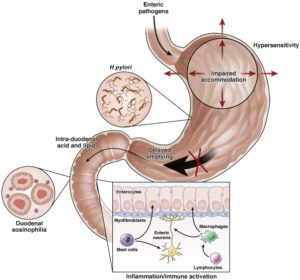DYSPEPSIA EDUCATION GUIDE
WHAT IS DYSPEPSIA ?
Dyspepsia (Indigestion) can be specified as a recurring and persistent pain or discomfort in the upper abdomen stomach). It is a usually a chronic condition in which the symptoms alter in frequency and severity, usually over a eriod of time like many months or years. The symptoms are often presented in a Periodic pattern such as it may occur every day or intermittently for days together or weeks at a time followed by days or weeks of relief.
 WHAT DOES THE STOMACH DO ?
WHAT DOES THE STOMACH DO ?
Stomach, is a saclike expansion of the digestive system, between the food pipe and the small intestine; it is located in he front portion of the abdominal cavity. The stomach serves as a temporary space for the storage and mechanical distribution of food before it is passed into the intestine.
DO I HAVE DYSPEPSIA ?
You may be suffering from Dyspepsia if you present one or more of the following symptoms,
1. Abdominal pain above the belly button
2. Nausea with or without vomiting
3. Burping and belching
4. Sensation of abdominal fullness (bloating)
5. Sensation of stomach fullness after consuming a very small amount of food
6. Abdominal bloating
7. Burning in the stomach or upper abdomen
8. Acidic taste
9. Growling stomach
What are the other conditions that present Dyspepsia like symptoms?
Dyspepsia or Indigestion is often a sign of an underlying problem, such as
• Ulcers
• Gastroesophageal reflux condition (stomach contents moving upwards into food pipe)
• Irritable bowel syndrome
• Stomach cancer (rare)
• Pregnancy
• Stomach infections
• Gastroparesis (a condition where the stomach muscle doesn’t let the stomach empty normally; this often occurs in people with diabetes)
• Thyroid diseases (Thyroid gland produces too much of hormones)
• Chronic pancreatitis
• Certain bacterial infections such as Helicobacter pylori
Living with Dyspepsia
Eat small meals so the stomach does not have to work as hard or as long
• Eat slowly
• Avoid acidic foods like citrus fruits and tomatoes
• Reduce caffeine consumption
• Don’t lie down right after eating
• Wait at least three hours after your last meal of the day before going to bed
• Manage stress like yoga, meditation, relaxation and biofeedback techniques
• Quit smoking & alcohol consumption
• Avoid wearing tight-fitting garments so that stomach contents cannot enter the esophagus.
• Don’t exercise with a full stomach
• Sleep with your head elevated (at least 6 inches) above your feet. This will prevent the digestive juices to enter into the esophagus.
Are you at risk?
Ulcers in the digestive tract
• Eating too much, eating too fast, eating high-fat foods, or eating during stressful situations
• Emotional factors, such as anxiety or depression
• During their periods, women often note that dyspepsia symptoms are worse.
• Cigarette smoking as it irritates the stomach mucosal lining
• Stress and fatigue
• Swallowing excessive air when eating may increase the symptoms of belching and bloating, which are often associated with indigestion.
• Excessive intake of alcohol as it irritates the inner protective layer of the stomach Sometimes people have the indigestion symptoms that do not relate to any of the above factors. This kind of indigestion problem is referred to as
functional, or non-ulcer dyspepsia.
When do I need to call the doctor?
Severe pain in the abdomen
Stomach Discomfort unrelated to eating
Loss of appetite
Vomiting or blood in vomit (the vomit may look like coffee grounds)
Weight loss
Black, or visible blood in stools.Symptoms similar to indigestion may be caused by heart attacks. If unusual indigestion presents along with other symptoms such as shortness of breath, sweating, chest pain, or pain radiating to the jaw, neck, or arm, seek medical attention immediately. Since indigestion is very common, almost all physicians can treat patients with indigestion. If it is not cured, please refer a gastroenterologist.
TREATMENT
Dyspepsia that is long lasting and isn’t controlled by lifestyle changes may require treatment. What treatment you receive depends on your signs and symptoms. Treatment may combine medications with behavior therapy.

